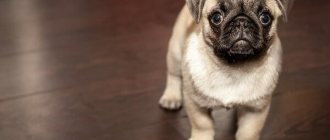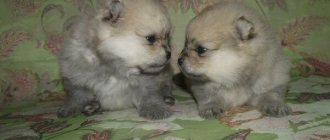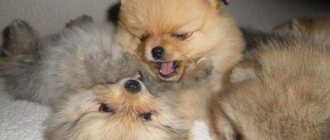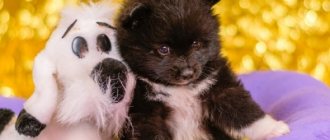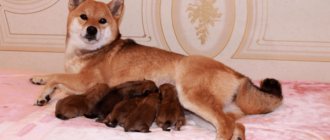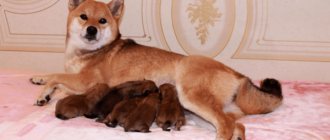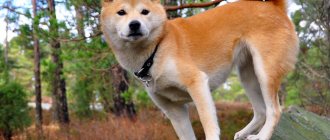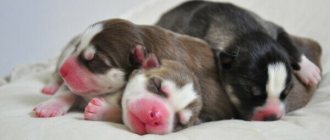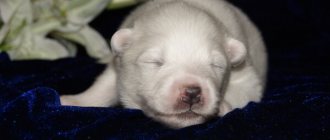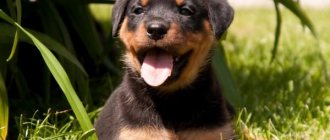Pug dogs are square, stocky dogs with a short muzzle.
Mentions of these animals are described in ancient Chinese manuscripts. The pug breed, like the Pekingese, undoubtedly comes from China, although they are also mentioned in the ancient Hindus.
These dogs were the favorites of the emperors of that era.
Their only purpose was to accompany the emperor. It is known that pugs had personal servants who carried them on special stretchers.
Since the establishment of trade routes between Europe and the Far East, about 400 years ago, pugs have gained popularity in Europe among both nobility and commoners.
There is a story about how a pug saved William of Orange by waking him up when the Dutch king’s camp was attacked by an enemy, and since then he has become the official dog of the House of Orange.
The pug was a favorite of Queen Victoria and Empress Josephine, wife of Napoleon.
Pug puppies: proper care
Buying a pug puppy is an excellent solution for those who want to make a loyal friend with whom they will be happy in any life situation. The Pug is an incredibly sweet breed of dog with a friendly and welcoming character, incredibly positive and cheerful. You can play happily with him, run around the park, hug, or just quietly watch a movie on TV together - this is a guaranteed good mood and the presence of a loved one to whom all your worries and experiences are extremely important.
However, before adopting a puppy, you should learn more about all the important details. How to care for a pug puppy, what are the characteristics of this breed, how to raise a pug and what you need to have in the house before buying.
Origin story
The breed is distinguished by the fact that in appearance their face resembles that of a monkey, with large, dark, wide-set eyes. For this reason, in England, pug dogs are called “Pug”, this is due to the humorous nickname of the cheerful monkeys.
The pug has been a ladies' dog since the 17th century, their charming ugliness complementing the beauty and sophistication of their owner..
A little about the characteristics of the breed
As a result of selection, dogs often receive not only an attractive exterior, but also, unfortunately, a number of genetic problems inherited from their ancestors. Let's talk a little about the disadvantages that are specific to pugs:
- A muzzle that is too short can cause difficulty breathing in puppies and adults, heart disease, and that snoring that is the hallmark of such dogs. Therefore, if you see that your pet is breathing very intensely, give him a break. And, except in the most extreme cases, you will have to completely abandon anesthesia.
The anatomical features of the breed may cause some health problems for the dog.
- Skin problems are very common for this species, so keep an eye on its condition - if spots, bald spots or abrasions appear, contact your veterinarian immediately. Caring for a pug puppy requires special attention to its folds - you will have to decide how to bathe the dog and treat any wounds that appear with special products.
- Pugs can also have problems with their eyes - they are quite large in this breed, so injuries from twigs, branches, and blades of grass are possible. Therefore, pay attention to tearfulness, squinting and other alarming symptoms.
The health of a dog very often depends on the health of its parents - before choosing a pug puppy, ask the breeder how the health of the parent couple is and what you should pay attention to in this particular individual.
What diseases can they suffer from?
A disease or pathology in a newborn dog can occur due to improper care or birth trauma. The most commonly observed deviations are:
- bloating;
- diarrhea;
- constipation;
- breathing problems;
- spasms.
Abdominal bloating occurs due to the fact that during the sucking process the animal takes in a large amount of air. At the beginning of complementary feeding, such a deviation may indicate overeating or the development of a fermentation process in the animal’s gastrointestinal tract.
Gases accumulate in the intestines. Over time, they cause pain and interfere with the normal functioning of the digestive system. To alleviate the animal’s condition, the following actions are performed:
- Give a gentle abdominal massage. The puppy should be placed on your left hand with its belly up, while using the fingers of your right hand to perform light massaging movements.
- Insert the thin rubber tip of the pipette into the anus. This procedure will help remove gases.
To avoid a negative reaction, you should try not to overfeed your dog and give it only high-quality and fresh food.
Sometimes regurgitation of a small part of the food is observed. This is due to overeating and swallowing air. If your puppy spits up after every meal, then he should be seen by a doctor.
Diarrhea can occur for various reasons. Most often it is provoked by a violation of the intestinal microflora.
For constipation, it is recommended to change the mother's diet if the dog only accepts her milk. In this case, it is recommended that an adult dog add vegetable oil to its food. If the puppy eats other food, a small amount of fiber should be introduced into its diet.
Difficulty breathing is accompanied by the following symptoms:
- the puppy is constantly trying to grab some air with his mouth;
- refuses food;
- tries to lift his head as high as possible.
The main reason for this deviation is narrow nasal openings; in rare cases, breathing problems are caused by narrow and tortuous nasal passages. In the first case, the doctor simply trims the nasal wings, thereby enlarging the nasal openings. The operation is carried out quite quickly, the risk of complications is minimal.
Such intervention should not be delayed, as this may negatively affect the development of the puppy. Due to the fact that he cannot breathe normally, the dog will be constantly in a state of oxygen starvation. In the most advanced cases, such a deviation is fatal.
Sometimes breathing problems can be accompanied by spasms. The following symptoms are observed:
- constant barking;
- body writhing;
- cyanosis of the tongue and mucous membranes;
- stopping breathing.
Often this condition occurs during a period of active growth due to a lack of vitamin D in the baby’s body. In this case, the doctor may prescribe medications that contain calcium. Drug therapy lasts for several days.
Pugs are a rather sickly breed. Allergic reactions of various origins can often occur. Other diseases include obesity and eye problems.
The weakest point in a small pug’s body is the heart. You should not subject him to great physical stress. The breed is also characterized by pathologies of the musculoskeletal system.
How to care for a pug
We will start our conversation about how to care for a pug, of course, with nutrition. Proper maintenance of a puppy implies proper organization of the feeding system - after all, dogs of this breed have an excellent appetite and are ready to snack at any time. It will be of little benefit to the puppy if the “compassionate” owner constantly feeds him with various treats - do not do this, despite the unhappy eyes of your pet.
Food can be:
- From natural products - meat, grains, fish, vegetables, fruits and vitamins.
- Dry food - make sure that the variety you choose is suitable for your child. This will be indicated by his mood, the condition of his coat, and his general constitution - caring for puppies in general is based on constant attention to their condition. Always buy food in reserve so that your child always has the exact variety he likes.
- Mixed - you combine canned food and dry food with natural products.
Don't forget to pamper your pet with treats - but in moderation
Each of the listed approaches has its pros and cons. The use of dry food guarantees stable stool, properly balanced and numerous vitamins and enzymes. However, despite all the advantages, this is an ersatz, which does not always put the puppy in a good mood - sometimes you want something tasty. Most experienced dog breeders practice a mixed version - in this case, the puppy receives all the necessary vitamins and at the same time cannot complain about boring monotony .
Caring for a pug also requires constant physical activity for it - do not forget that this is a fairly active and agile breed that requires frequent and long walks. A male dog will need a “promenade” of at least half an hour in order to empty the bladder and intestines; a female dog will cope much faster, but this is not the only question.
Caring for a pug puppy is based on full walks, which cannot include a short walk to the toilet. for a puppy to walk in any weather - you do not need to dress him in warm clothes and wrap him up, he will not freeze if he moves actively. And he needs this - training a puppy includes a lot of outdoor games so that he grows up strong and fit, and not a four-legged barrel.
Pugs respond well to training during playtime.
If you don’t want to constantly wash your pet after a walk in the rainy park, dress him in waterproof overalls. In winter, you can provide him with clothes lined with synthetic padding, but it would be more correct to prevent the dog from freezing by playing and running.
Regarding hygiene, avoid washing your pet too often with shampoos and other detergents. This can disrupt the natural acid-base balance of his skin and damage his fur. Therefore, before bathing your dog, think about whether this is really necessary - after a walk, it is enough to wash the paws and tummy.
Don’t forget about trimming the claws - this needs to be done with a special nail clipper; if you are not sure that you can do it yourself, contact a professional grooming center. However, if your dog walks on asphalt, there is no need to trim his nails - they will chip themselves on the hard surface. Pugs are brushed only during periods when they shed; this is best done with a special rubber glove.
Photo gallery
To ensure that your pet is always cheerful and active, do not forget to do the necessary hygiene and preventive procedures that we described above on time. Now let's look at the photos of these cute fatties.
The author of the video gives practical and very useful advice on keeping pugs. You will learn about the pros and cons of this breed from a person who has encountered them first-hand. Enjoy watching.
Sources:
https://vplate.ru/mops/uhod-i-soderzhanie/ https://zoodoma.com/sobaki/malenkie-porody/mops/uhod-za-sobakoj.html https://vsepesiki.ru/porody/mopsy /uxod.html
Getting ready for the baby's arrival
Before you bring your pet to a new place of residence, you should make sure that the puppy in your home has everything he needs:
- A place to sleep - when the dog arrives in your home, he will need somewhere to sleep. Find a quiet place where it’s warm and free of drafts, and arrange a bed there - but at the same time, your pupil should not feel isolated. As for organizing a place to sleep, it could be a cute mattress with a cover or a diaper - there are requirements for a diaper in terms of softness and washability. To the question of how to teach a puppy to sleep in its place, the answer is simple - first, place a dog bed near your bed. And under no circumstances allow him to climb into your bed - otherwise you will hardly be able to find a way to wean him off this.
- Bowls for food and clean water - it will be convenient if they are on tripods.
- A toilet can be a rag or a diaper at first, but it is better to have a special tray from the very beginning. To the question of what age to toilet train, the answer is simple - the earlier, the better. If you waste time, you won’t figure out how to wean your dog off the floor.
- Toys – you should definitely take care of them, since pugs need to be constantly played with. Toys can be anything - the main thing is that they are not traumatic for the dog. In addition, this is a good “switch” of energy if the dog is prone to biting, and you want to wean him from it.
The period of active shedding in a pug begins in early spring and late autumn.
False pregnancy
False pregnancy is not so rare. A pug's heat is a change in the animal's hormones. In some cases, after it the dog may exhibit symptoms of pregnancy, even if the owner did not breed his animal. She becomes lazy and lethargic, increases her weight, her stomach becomes much larger, and in some cases milk is secreted.
Sometimes the appearance of childbirth appears; the dog is preparing a place for a future event and its offspring.
Then the animal chooses a false object, which she considers her puppy, and begins to groom, showing concern for the fictional offspring. This is categorically impossible to allow; in fact, immediately from the moment of the “false birth”, reduce the amount of food and drink for the animal, hide the false offspring, and remove the constructed bed.
If this is not done, the pug will begin to behave aggressively, protecting the “false family”. In case of serious deviations from normal behavior, immediately contact a specialist.
What is needed for maintenance?
Before purchasing a pug puppy, you need to worry in advance about the proper organization of the place where the baby will rest, sleep and eat. Newborn pugs, like representatives of other breeds, at first require special conditions of detention.
Experts do not recommend setting aside a place for the baby next to heating devices and on the aisle where a draft is possible. The puppy should not be placed in isolated places such as a balcony or closet.
Since this breed of dog is characterized by its small size, you can install a bed for your pet with dimensions of 40*60*70 cm. A flexible mattress in a removable cover is usually placed on it, which is convenient to use and easy to wash. In the first days after the puppy arrives in the house, the lounger should be placed near the owner’s bed, so the baby will not feel lonely and will not be afraid.
If the housing area allows it, you can install an original mini-house for the pug. It will serve as an excellent place for the animal to rest.
In addition, for your pet you will need to additionally buy two bowls, a harness or collar with a leash for walking, a metal comb and products for caring for folds and eyes. The volume of bowls should be up to 1 liter. To prevent your little pug from getting bored in his free time, he needs to buy a set of toys.
Vaccination
Vaccination or vaccination is an event that is aimed at preventing the formation of contagious diseases that are life-threatening to a dog. Vaccination also applies to pug care.
Preparation is important for vaccination. Because you cannot walk a dog and introduce it to other dogs if it is not vaccinated. Approximately 7 days before the 1st vaccination, it is necessary to perform a procedure to remove worms.
The first vaccination is given to the puppy at approximately 2 months, and the second is performed 3 weeks later - before the teeth change. Today, complex vaccinations have proven themselves to be the best.
A passport is issued at the veterinary clinic, which indicates the number of vaccinations performed and the name of the substance used. Walking is allowed approximately 1.5 weeks after the 2nd vaccination.
How to take care of your appearance?
Despite the fact that a pug is easy to keep, after it appears in the house, the owner must be prepared to change many habits and rules. At home, the animal must be given maximum care and attention, since its beauty and health will depend on this. Caring for a puppy involves performing activities such as regular cleaning of ears, teeth and cutting nails. They are carried out as follows.
- Ears. This part of the body in pets of this breed needs special attention, since the dog is prone to diseases such as otitis media. To prevent it and maintain frequency, it is recommended to clean the ears twice a month, using a special lotion (it can be purchased at any pet store), hydrogen peroxide (3%) or boric alcohol. Moisten a cotton pad in the chosen product and carefully clean the ear folds so that no dirt, sawdust or hair remains in them.
In addition, you need to drop drops inside, massage them for half a minute and then thoroughly clean the inside of the ear with a cotton swab.
- Teeth . Caring for them is considered the most important; regular teeth cleaning is included in the list of mandatory hygiene procedures. To remove plaque from the teeth of a young dog, you need to use the services of a veterinarian, since this is done under anesthesia. For pets over the age of 7 years, the procedure cannot be performed under anesthesia, as their heart will not withstand it. In this case, special toothpaste is used for cleaning. If it is not there, then at home you can clean the plaque using a terry cloth soaked in a soda solution.
- Claws. To care for them, you need to purchase a nail clipper. This device will help avoid delamination and creases. It is recommended to trim the nails as they grow, usually several times a month. The procedure must be carried out carefully, otherwise you can damage living tissue and provoke bleeding. If the claws are not trimmed in a timely manner, they will interfere with the pet while moving and cause deformation of the fingers.
is also considered important in caring for a pug . It is necessary to bathe representatives of this breed as their fur becomes dirty, since frequent water treatments can harm the pet - when the biological film is washed off, dandruff appears on the pug’s skin and the fur becomes dull and brittle. When washing your dog, you should cover your pet's ears with cotton swabs and provide protection from water getting into the eyes.
a brief description of
Pugs are funny, inquisitive, friendly, self-loving, and the sounds made by these cuties (grunting, snoring, snorting) attract everyone's attention.
They are devoid of aggressiveness and are very attached to their owner.
Pugs are excellent companions; they are ready to participate in everything their owner does; they are able to get rid of a bad mood, as they are cheerful and good-natured..
The breed standards adopted in our time prescribe several types of heads for pugs: a convex rectangular skull, with a wide part of the muzzle and a normal shape.
The body is “square format”; the length of the body is equal to the height at the withers. The dog should look harmonious, all parts of its body are proportional.
Read more detailed characteristics of the breed here.
Walking features
It is recommended to keep pugs in an apartment or private house, but this does not mean that the pet does not need walks at all. Representatives of this breed should be walked twice a day. When walking outside, you should monitor the general condition of the dog and prevent it from freezing or overheating. In case of bad weather, it is advisable to reduce the walking time to a minimum. After each walk, the pug needs to wash its paws with a special brush.
In spring and summer, after walking, you should check your dog for ticks, which can attach themselves to the animal’s paws and belly. The folds on the face require special attention after walks - not only can ticks crawl into them, but also dirt and dust can become clogged. During the cold season, your pet needs to be dressed in clothes, as this breed is “afraid” of hypothermia.
Walks should only be carried out on a leash with a collar; this will help protect your four-legged friend from contact with sick and aggressive animals.
Education and training
Pugs are capricious and stubborn animals, but are considered to have high intelligence. There are several stages for their education:
- Get used to his name.
- Toilet train.
- Train him to use a collar and leash.
- Get rid of bad habits.
Start training by teaching the puppy to your voice and his name.
If you want to feed him, play or pet him, then call the dog in a gentle voice.
Use prohibitory commands when the pet tries to chew or spoil any lice thing. Change your voice, make it angry and unpleasant during such commands.
It's easy to toilet train your pet. After each feeding and sleep, take the pug outside or put it in a tray. These simple steps will help him quickly get used to the toilet. To develop your pet's dexterity and intelligence, spend more time playing. Buy him as many toys as possible that all dogs love.
Hitting or shouting at a pug is prohibited! He will close himself off and start doing bad things specifically to take revenge. Be patient and persistent while raising and training your animal.
Pug feeding rules
The pug is a lover of food, so it is necessary to monitor the animal’s diet to avoid obesity. This baby is a beggar and loves to eat tasty things.
- From an early age, the pug must be limited in food . Puppies are fed small portions 4-5 times a day. When he reaches six months of age, the number of feedings is reduced to 3 times, and after 8 months the animal is fed as an adult - 2 times a day.
- A pug's diet should include meat . It can be horse meat, beef, veal - any lean meat except pork. It's hard for a pug's stomach to digest.
- Cereals are a source of fiber and microelements . The dog can be fed porridges made from pearl barley, rice, and buckwheat.
- The animal's diet must contain vitamins . Fresh fruits and vegetables after heat treatment will replenish the body with essential minerals.
- Dairy should also be in your pug's bowl. It is better to give him fermented milk (low-fat cottage cheese, kefir, fermented baked milk). Milk causes stomach upset in the baby. It's better to exclude it. Due to the structure of the jaws, it is difficult for the dog to eat liquid food. Therefore, you need to give preference to solid, finely chopped foods.
There are a variety of dry and wet foods available on the market that are designed specifically for pugs. They fully satisfy the dog’s needs, and the balanced composition does not require additional vitamin and mineral supplements. In addition, the food contains more plant proteins and less fat, which helps prevent obesity in little gluttons.
Features of hygiene procedures
- Bathing . Pugs are domestic dogs and therefore do not require frequent bathing. It is enough to wash the animal when it gets dirty.
- Combing . To keep your dog's fur shiny and well-groomed, it is enough to brush it once a week, and during shedding - once every two days. Specialized stores sell brushes - mittens with metal teeth or natural bristles. You need to comb according to the growth of the coat, softly and delicately. Pugs, accustomed from childhood, love the grooming process and do not resist grooming.
- Claws . Pug claws also require care. They do not grind down on their own and can deform the toes if they are not trimmed. This procedure should be done 1-2 times a month.
- Ears . Babies' ears require special attention. They can break at the age of 3-4 months. To maintain the correct shape of the ears, you need to glue them with a regular adhesive plaster. The rules for carrying out such a procedure can be obtained from a veterinarian or an experienced breeder. You also need to clean your ears properly. Carefully enough, trying not to damage the ear canal, clean the ear of wax and dust with an ordinary ear stick moistened with sea buckthorn oil. Residues must be removed with a dry cosmetic disc.
Vaccinations
Pugs need vaccinations not only to protect them from serious diseases, but also so that they can travel abroad and participate in exhibitions. Only healthy dogs are vaccinated. Before visiting the veterinarian, you need to get treated for parasites. The dog is vaccinated for the first time at two and a half months, and two weeks later they are vaccinated again. A second course of vaccinations is necessary for a pug after his teeth change. Then the course should be repeated every year to protect your pet from many problems.
Pug Eye Care
Pug eyes, due to the peculiarities of their anatomical structure, are often subject not only to infection, but also to frequent injuries. Clean the dog's eyes with a dry cotton pad or swab, removing mucus and dust. If not only mucous membranes, but also purulent crusts appear, this indicates inflammatory processes.
Eye diseases can be treated by placing tetracycline eye ointment or chloramphenicol or kanomycin ointment behind the eyelid. If the dog's tears flow as a result of an injury, drops are placed in the eyes, alternating between an antibiotic and a regenerating agent. In any case, you should immediately consult a doctor.
Since the eyes of dogs of this breed are often subject to corneal erosion, eversion of the eyelids, or atypical eyelash growth, you need to carefully monitor their health. At the slightest sign of pathology, you should seek medical help.
Treatment of skin folds
Muzzle . The pug's folded face also requires care. Sweat, dust, and discharge from the eyes accumulate in the folds, causing an unpleasant odor and irritation. The folds are cleaned with special hypoallergenic wet wipes, cotton pads soaked in alcohol-free lotion for baby skin, hydrogen peroxide, chlorhexidine solution and sprinkled with baby powder. It is enough to carry out the procedure once a week, but if the folds are massive and impede air circulation, then you need to clean the folds twice a week.
Nose . The tip of the pug's nose also requires care. Its skin is dry and prone to cracking. Therefore, the nose also needs to be nourished - lubricated with baby oil.
If the skin in the folds is inflamed, then experienced dog breeders recommend treating the inflammation with Levomikol or Malovit ointments. They eliminate pimples, diaper rash, and irritation. But before treatment, you need to consult a veterinarian, since the cause of inflammation can be demodicosis, a disease caused by a skin mite.
